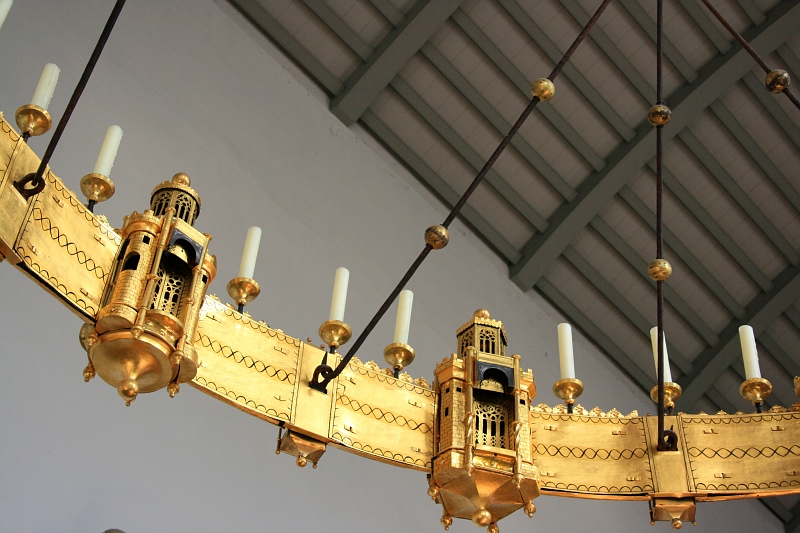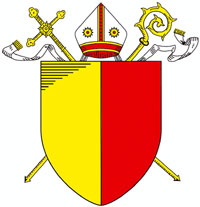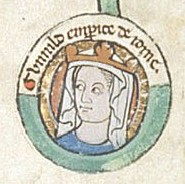|
Azelin
Azelin (before 1000 – 8 March 1054) was Bishop of Hildesheim from 1044 until 1054. Azelin's origin is not known. He was appointed Bishop of Hildesheim by Emperor Henry III, succeeding Thietmar. During his tenure, the cathedral built by Altfrid was destroyed by a fire on 23 March 1046, along with works of art and documents. Azelin's plans to build a new cathedral were not successful. The wheel chandelier known by his name as the Azelin chandelier was possibly donated by Thietmar. He died in Hildesheim and was succeeded by Hezilo. Literature * Adolf Bertram Adolf Bertram (14 March 1859 – 6 July 1945) was archbishop of Breslau (now Wrocław, Poland) and a cardinal of the Roman Catholic Church. Early life Adolf Bertram was born in Hildesheim, Royal Prussian Province of Hanover (now Lower Saxony), ...: ''Geschichte des Bisthums Hildesheim''. Lax, Hildesheim u. a. 1899–1925, vol. 1, pp. 100–107. References 11th-century German Roman Catholic bishops R ... [...More Info...] [...Related Items...] OR: [Wikipedia] [Google] [Baidu] |
Azelin Chandelier
The Azelin chandelier (german: Azelinleuchter) is a Romanesque wheel chandelier, made in the 11th century for the Hildesheim Cathedral in Hildesheim, Germany, a UNESCO World Cultural Heritage site since 1985. It is the oldest of four extant wheel chandeliers from that period, along with the Hezilo chandelier, also in Hildesheim, the Barbarossa chandelier in the Aachen Cathedral, and the Hartwig chandelier in the Abbey of Comburg. It was believed to be donated by Bishop Azelin, however his predecessor Thietmar is more likely to be the patron. Therefore, the chandelier is also called the Thietmar chandelier (''Thietmarleuchter''). Description A wheel chandelier is also called a ' (crown) and circular chandelier.Julia de Wolf AddisonArts and Crafts in the Middle Ages Medieval Histories Like the later and larger Hezilo chandelier, the Azelin chandelier is a circular hoop of gilt copper and tinplate, decorated with twelve towers and twelve gatehouses. However, the decoration is m ... [...More Info...] [...Related Items...] OR: [Wikipedia] [Google] [Baidu] |
Hezilo Of Hildesheim
Hezilo of Hildesheim,Thompson, James Westfall (1928). ''Feudal Germany'', University of Chicago Press, Chicago, Cambridge University Press, London, p. 206. also known as Hezelo, Hettilo or Ethilo (betw. 1020 and 1025–1079), was Bishop of Hildesheim from 1054 to 1079. Life Hezilo probably came from a Frankish family and is likely to have received his theology training in Bamberg. Under Emperor Henry III, he was a member of the court chaplaincy (''Hofkapelle'') in 1051/52, initially as the provost of St. Simon and Jude in Goslar and then in 1053 as Chancellor of Italy. In 1054, he became the successor to Azelin as Bishop of Hildesheim. Hezilo was concerned to maintain the position of Hildesheim in and around Goslar, the heart of the Salian royal estate, where he and other leading members of the episcopate (including Adalbert of Bremen and Anno of Cologne) could exploit the situation whilst Henry IV was still a minor. In Goslar, he founded the Church of St. James the Elder ... [...More Info...] [...Related Items...] OR: [Wikipedia] [Google] [Baidu] |
Bishop Of Hildesheim
This list records the incumbents of the Roman Catholic Diocese of Hildesheim (german: link=no, Bistum Hildesheim). Between 1235 and 1803 the bishops simultaneously officiating as rulers of princely rank (prince-bishop) in the Prince-Bishopric of Hildesheim (german: link=no, Hochstift Hildesheim), a state of imperial immediacy within the Holy Roman Empire. Hildesheim is the seat of the bishops and the cathedral chapter. Titles of the incumbents of the Hildesheim See Between 1235 and 1803 the elected and papally confirmed bishops of the Hildesheim See were additionally imperially invested princely power as prince-bishops. In 1235 part of the Hildesheim diocesan territory, the episcopal and capitular temporalities (Stift) were disentangled from the Duchy of Brunswick and Lunenburg and became an own territory of imperial immediacy called Prince-Bishopric of Brunswick and Lunenburg (german: link=no, Hochstift Hildesheim), a vassal of the Holy Roman Empire. The prince-bishopric wa ... [...More Info...] [...Related Items...] OR: [Wikipedia] [Google] [Baidu] |
Wheel Chandelier
A wheel chandelier is a lighting installment, in the form of a chandelier hanging from the ceiling in the form of a spoked wheel. The oldest and most important examples derive from the Romanesque period. Wheel chandeliers were made for the practical purpose of lighting the great churches and other public areas, but in religion they also had symbolic significance, depicting the Garden of Eden or the Kingdom of God. The wheel, its gates, and its towers, which are usually decorated with Prophets and Apostles or inscribed with their names, symbolise the city walls of the New Jerusalem. The buttresses, towers, and candles number twelve or a multiple of twelve, after the numerology of the Book of Revelation. This symbolism is first found on two wheel chandeliers of Hildesheim Cathedral. The great wheel chandelier of the Church of the Holy Sepulchre was an inspiration. Romanesque wheel chandeliers In Germany there are four great Romanesque wheel chandeliers. The fact that they are mad ... [...More Info...] [...Related Items...] OR: [Wikipedia] [Google] [Baidu] |
Henry III, Holy Roman Emperor
Henry III (28 October 1016 – 5 October 1056), called the Black or the Pious, was Holy Roman Emperor from 1046 until his death in 1056. A member of the Salian dynasty, he was the eldest son of Conrad II and Gisela of Swabia. Henry was raised by his father, who made him Duke of Bavaria in 1026, appointed him co-ruler in 1028 and bestowed him with the duchy of Swabia and the Kingdom of Burgundy ten years later in 1038. The emperor's death the following year ended a remarkably smooth and harmonious transition process towards Henry's sovereign rule, that was rather uncharacteristic for the Ottonian and Salian monarchs. Henry succeeded Conrad II as Duke of Carinthia and King of Italy and continued to pursue his father's political course on the basis of ''virtus et probitas'' (courage and honesty), which led to an unprecedented sacral exaltation of the kingship. In 1046 Henry ended the papal schism, was crowned Emperor by Pope Clement II, freed the Vatican from dependence on the Roma ... [...More Info...] [...Related Items...] OR: [Wikipedia] [Google] [Baidu] |
Thietmar Of Hildesheim
Thietmar of Hildesheim, also Tymmo, Tiemo, Thietmarus, Thetmarus, Thiatmarus, Diothmarus, Deotharus, T(h)etmarus, Detmarus, Deithmarus, Teythmarus, (died 14 November 1044 in Hildesheim) was Bishop of Hildesheim from 1038 to 1044. He was a native Dane. He was first mentioned when he accompanied Gunhilda, the daughter of Canute the Great, to Nijmegen, where she married Henry III on June 29, 1036, and took the name of Cunegonde. He was chaplain to the Queen, and thus a member of the royal court orchestra. Thietmar was appointed Bishop of the diocese of Hildesheim on 5 May 1038. On 20 August he received episcopal consecration in Lorsch by Archbishop Bardo of Mainz. In 1039 he appointed Adelaide, daughter of Otto II, as abbess in Gandersheim Abbey. He is buried in Hildesheim Cathedral Hildesheim Cathedral (German: '), officially the Cathedral of the Assumption of Mary (German: ''Hohe Domkirche St. Mariä Himmelfahrt'') or simply St. Mary's Cathedral (German: ''Mariendom''), is a med ... [...More Info...] [...Related Items...] OR: [Wikipedia] [Google] [Baidu] |
Altfrid
Saint Altfrid (or Altfrid of Hildesheim) (died 15 August 874) was a leading figure in Germany in the ninth century. A Benedictine monk, he became Bishop of Hildesheim, and founded Essen Abbey. He was also a close royal adviser to the East Frankish King Louis the German. He is a Roman Catholic saint. His feast day is celebrated on 15 August, the feast of the Assumption of the Virgin Mary, but also in Essen and Hildesheim on 16 August. Life There is no contemporary biography of Altfrid. He is first mentioned by name on 3 October 852, when he took part in a council in Mainz as Bishop of Hildesheim. According to the ''Hildesheim Chronicle'' Altfrid died "rich in days" in 874, from which a year of birth of around 800 is assumed. He owned land in the Harzvorland and in central Essen (''Asnithi''), which may have been inherited from his family, and it seems likely that he belonged to the Saxon nobility, and may have been connected to the Imperial family of the Liudolfings, who, howev ... [...More Info...] [...Related Items...] OR: [Wikipedia] [Google] [Baidu] |
Adolf Bertram
Adolf Bertram (14 March 1859 – 6 July 1945) was archbishop of Breslau (now Wrocław, Poland) and a cardinal of the Roman Catholic Church. Early life Adolf Bertram was born in Hildesheim, Royal Prussian Province of Hanover (now Lower Saxony), Germany. He studied theology at the University of Munich, the University of Innsbruck, and the University of Würzburg, where he obtained a doctorate in theology, and at the Pontifical Gregorian University in Rome, where he earned a doctorate in canon law in 1884. He was ordained a Roman Catholic diocesan priest in 1881. On 26 April 1906 he was elected bishop of Hildesheim, an election that received papal confirmation on 12 June 1906. Eight years later, on 8 September 1914, the Pope confirmed his election by the cathedral chapter of Breslau as bishop of that see, and he took possession of it on 28 October. Since 1824 the title Prince-Bishop of Breslau was a merely honorific title granted to the incumbents of the see, without a prince-bi ... [...More Info...] [...Related Items...] OR: [Wikipedia] [Google] [Baidu] |
Footnotes
A note is a string of text placed at the bottom of a page in a book or document or at the end of a chapter, volume, or the whole text. The note can provide an author's comments on the main text or citations of a reference work in support of the text. Footnotes are notes at the foot of the page while endnotes are collected under a separate heading at the end of a chapter, volume, or entire work. Unlike footnotes, endnotes have the advantage of not affecting the layout of the main text, but may cause inconvenience to readers who have to move back and forth between the main text and the endnotes. In some editions of the Bible, notes are placed in a narrow column in the middle of each page between two columns of biblical text. Numbering and symbols In English, a footnote or endnote is normally flagged by a superscripted number immediately following that portion of the text the note references, each such footnote being numbered sequentially. Occasionally, a number between brack ... [...More Info...] [...Related Items...] OR: [Wikipedia] [Google] [Baidu] |
11th-century German Roman Catholic Bishops
The 11th century is the period from 1001 ( MI) through 1100 ( MC) in accordance with the Julian calendar, and the 1st century of the 2nd millennium. In the history of Europe, this period is considered the early part of the High Middle Ages. There was, after a brief ascendancy, a sudden decline of Byzantine power and a rise of Norman domination over much of Europe, along with the prominent role in Europe of notably influential popes. Christendom experienced a formal schism in this century which had been developing over previous centuries between the Latin West and Byzantine East, causing a split in its two largest denominations to this day: Roman Catholicism and Eastern Orthodoxy. In Song dynasty China and the classical Islamic world, this century marked the high point for both classical Chinese civilization, science and technology, and classical Islamic science, philosophy, technology and literature. Rival political factions at the Song dynasty court created strife amongst th ... [...More Info...] [...Related Items...] OR: [Wikipedia] [Google] [Baidu] |
Roman Catholic Bishops Of Hildesheim
Roman or Romans most often refers to: *Rome, the capital city of Italy *Ancient Rome, Roman civilization from 8th century BC to 5th century AD *Roman people, the people of ancient Rome *''Epistle to the Romans'', shortened to ''Romans'', a letter in the New Testament of the Christian Bible Roman or Romans may also refer to: Arts and entertainment Music * Romans (band), a Japanese pop group * ''Roman'' (album), by Sound Horizon, 2006 * ''Roman'' (EP), by Teen Top, 2011 *" Roman (My Dear Boy)", a 2004 single by Morning Musume Film and television *Film Roman, an American animation studio * ''Roman'' (film), a 2006 American suspense-horror film * ''Romans'' (2013 film), an Indian Malayalam comedy film * ''Romans'' (2017 film), a British drama film * ''The Romans'' (''Doctor Who''), a serial in British TV series People *Roman (given name), a given name, including a list of people and fictional characters *Roman (surname), including a list of people named Roman or Romans *Ῥωμα� ... [...More Info...] [...Related Items...] OR: [Wikipedia] [Google] [Baidu] |
990s Births
99 may refer to: * 99 (number), the natural number following 98 and preceding 100 * one of the years 99 BC, AD 99, 1999, 2099, etc. Art, entertainment, and media * ''The 99'', a comic series based on Islamic culture Film, television and radio * 99 (1918 film), ''99'' (1918 film), a Hungarian film * 99 (2009 film), ''99'' (2009 film), an Indian Hindi film * 99 (2019 film), ''99'' (2019 film), an Indian Kannada film * The 99 (TV series), ''The 99'' (TV series), a 2011–2012 animated series * Agent 99, a fictional character in the 1960s American TV series ''Get Smart'' * WNNX (99X), classic "Rock 100.5" FM, in Atlanta, Georgia * ''Brooklyn Nine-Nine'', an American television police sitcom based in the fictional 99th precinct of the New York City Police Department, NYPD ** 99 (Brooklyn Nine-Nine), 99 (''Brooklyn Nine-Nine'' episode) * 99, a List of Star Wars characters#clone trooper, clone trooper character from ''Star Wars: The Clone Wars'' Games * '''99: The Last War'', a renamed ... [...More Info...] [...Related Items...] OR: [Wikipedia] [Google] [Baidu] |




